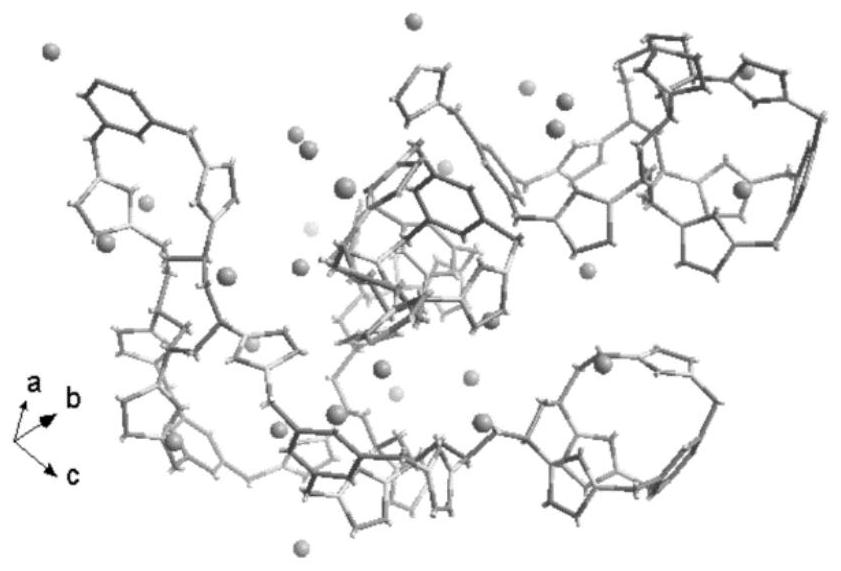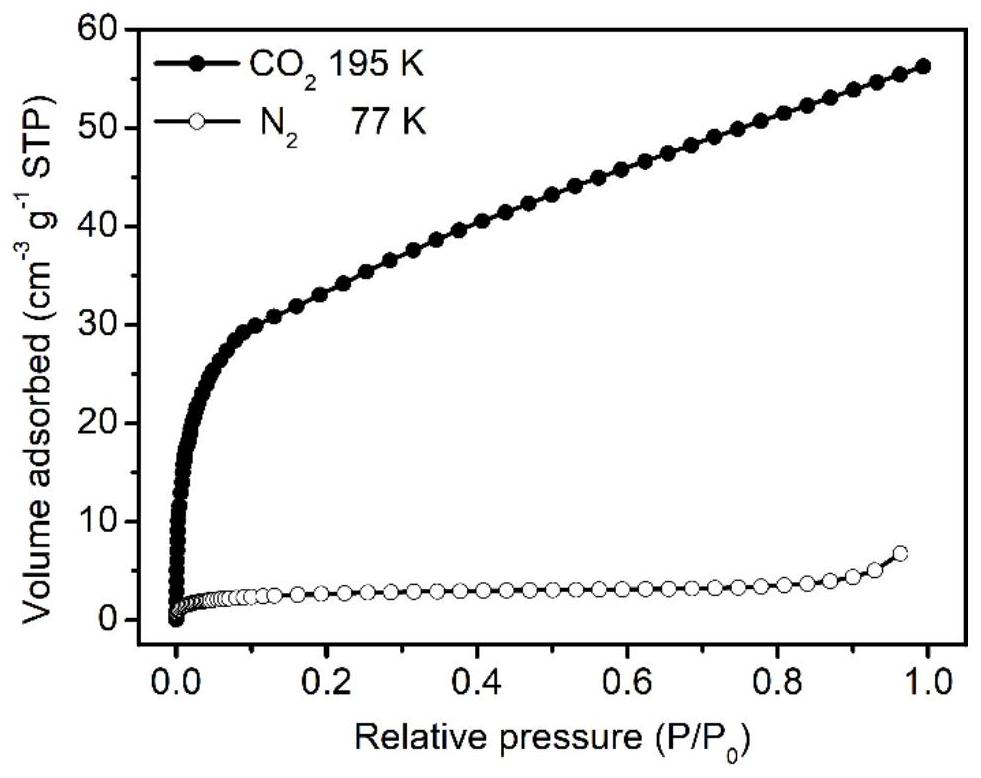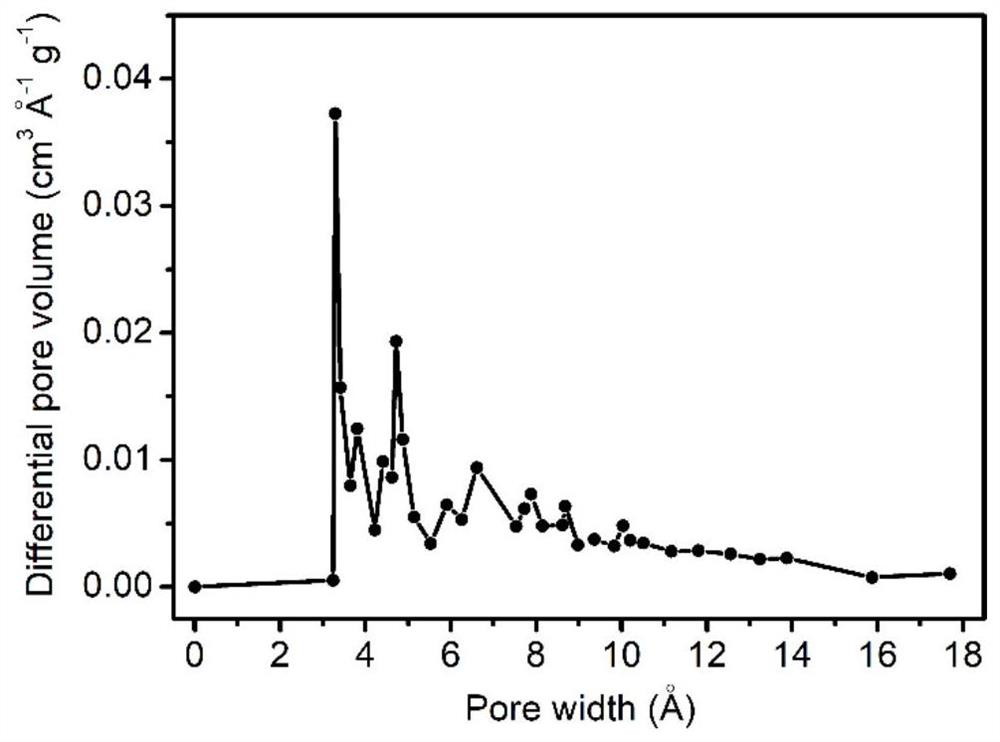A class of ultramicroporous ionic polymer material and its preparation method and application
An ionic polymer and ultra-microporous technology, applied in separation methods, chemical instruments and methods, filtration separation, etc., can solve the problems of low absorption capacity, high viscosity, and difficult recovery of ionic liquids, and achieve enhanced molecular recognition capabilities and preparation The method is simple and the effect of efficient use
- Summary
- Abstract
- Description
- Claims
- Application Information
AI Technical Summary
Problems solved by technology
Method used
Image
Examples
Embodiment 1
[0063] Weigh 5g of 1,3,5-tris(bromomethyl)benzene and 4.35g of vinylimidazole, add them into 250mL of acetonitrile, mix and dissolve under stirring, and then heat to 50°C for 36 hours to react. The obtained product was filtered and washed with acetonitrile, and then vacuum-dried at 65°C for 24 hours to obtain a white solid, i.e. hyperbranched ionic liquid Ph-3MVIm-Br (Ph is a benzene ring group, 3 represents the number of hyperbranched, MVIm represents 1 -vinyl-3 methyleneimidazolium cation, Br is an anion), its molecular structure is shown in formula (2-1), and the yield is about 80%.
[0064]
Embodiment 2
[0066] Weigh 1.0 g of the hyperbranched ionic liquid Ph-3MVIm-Br obtained in Example 1 and 0.03 g of azobisisobutyronitrile into a mixed solution of 10 mL of ethanol and 5 mL of water, mix and dissolve under stirring, and then heat to 70 ° C for 12 hours . The obtained product P(Ph-3MVIm-Br) was filtered, washed with water and methanol, and then dried under vacuum at 65°C for 24 hours to obtain a white solid powder with a yield of about 85%. Such as figure 2 and image 3 As shown, the material in CO 2 (195K) as the medium, the measured Langmuir specific surface area is 244m 2 / g, the total pore volume is 0.104cm 3 / g, the aperture is Adsorbent P(Ph-3MVIm-Br) in N 2 (77K) as the medium, the specific surface area is only 10.0 m 2 / g. This result indicates that P(Ph-3MVIm-Br) is an ultramicroporous material. Such as Figure 4 As shown, the thermogravimetric results show that the material has excellent thermal stability, and the thermal decomposition temperature is as ...
Embodiment 3
[0072] Weigh 5g of 1,3,5-tris(chloromethyl)benzene and 6.95g of vinylimidazole, add them into 250mL of acetonitrile, mix and dissolve under stirring, and then heat to 50°C for 36 hours to react. The obtained product was filtered and washed with acetonitrile, and then vacuum-dried at 65° C. for 24 hours to obtain a white solid, namely hyperbranched ionic liquid Ph-3MVIm-Cl, with a yield of about 80%.
[0073] Weigh 1.0g hyperbranched ionic liquid Ph-3MVIm-Cl and 0.03g azobisisobutyronitrile into 10mL N,N-dimethylformamide and 5mL water mixed solution, mix and dissolve under stirring, then heat to 80 °C for 12 hours. The obtained product P(Ph-3MVIm-Cl) was filtered, washed with water and methanol, and then dried under vacuum at 65°C for 24 hours to obtain a white solid powder with a yield of about 80%. CO under 195K 2 The results of the adsorption isotherm show that the Langmuir specific surface area of the material is 184m 2 / g, the total pore volume is 0.081cm 3 / g, the ...
PUM
| Property | Measurement | Unit |
|---|---|---|
| specific surface area | aaaaa | aaaaa |
| thermal decomposition temperature | aaaaa | aaaaa |
| specific surface area | aaaaa | aaaaa |
Abstract
Description
Claims
Application Information
 Login to View More
Login to View More - R&D
- Intellectual Property
- Life Sciences
- Materials
- Tech Scout
- Unparalleled Data Quality
- Higher Quality Content
- 60% Fewer Hallucinations
Browse by: Latest US Patents, China's latest patents, Technical Efficacy Thesaurus, Application Domain, Technology Topic, Popular Technical Reports.
© 2025 PatSnap. All rights reserved.Legal|Privacy policy|Modern Slavery Act Transparency Statement|Sitemap|About US| Contact US: help@patsnap.com



